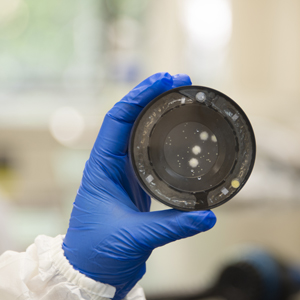blog
October 31, 2013 | Source: Rapid Micro Biosystems, Inc.
Shortening the Quality Control Process with Rapid Microbial Testing
POSTED BY Rapid Micro Biosystems | 5 minute read
October 31, 2013 | Source: Rapid Micro Biosystems, Inc.
POSTED BY Rapid Micro Biosystems | 5 minute read
 Time is always of the essence in quality control testing. Every day of waiting for colonies to form is another day manufacturing is slowed, production lines are halted or inventory waits to be shipped. Consistent output is even more important when the clock is ticking on a patent. Despite advances in manufacturing techniques, however, the current method for microbial contamination testing relies on slow, error-prone processes that can hold up production for weeks at a time.
Time is always of the essence in quality control testing. Every day of waiting for colonies to form is another day manufacturing is slowed, production lines are halted or inventory waits to be shipped. Consistent output is even more important when the clock is ticking on a patent. Despite advances in manufacturing techniques, however, the current method for microbial contamination testing relies on slow, error-prone processes that can hold up production for weeks at a time.
Today, new automatic enumeration and reporting technologies can drastically reduce both total time and labor hours spent on microbial testing. By automating and integrating mundane, repetitive and error-prone tasks, pharmaceutical companies can dramatically decrease their products' times to market. The following are just a few of the ways rapid microbial testing can shorten the quality control process.
Because manual microbial counting relies on detection by the naked eye, a typical water test can take 7 days for final results. With advanced imaging technology, rapid enumeration can produce reliable results in roughly half that time. Colonies produce natural autoflouresence, which can be detected by the combination of a light of a specific frequency, high resolution imaging, and proprietary algorithms. With manual methods, these cells have to multiply into the millions or tens of millions before microbiologists can spot them.
Aside from quicker colony detection, automated microbial tests are capable of far higher throughput than manual processes. As has been proven in multiple industries, automation is always faster than an individual, even a microbiologist. Automated technology with the Growth Direct™ System can handle a high volume of samples, and has two incubators to support serial incubation assays. These capabilities not only allow for more rapid enumeration; they enable higher-volume testing, such as environmental monitoring with reliable results.
Automatic enumeration completely eliminates the need for manual data entry. Cassettes are labeled with a barcode system that integrates with existing laboratory information systems (LIMS), and results are instantly uploaded once the machine completes its counts. This process also eliminates entry errors and makes it far easier for QC personnel to compile results and analyze trends. With so much extra time, microbiologists are free to design and oversee other tests and investigations.
With traditional testing, microbiologists don't discover out-of-specification (OOS) samples until the end of the assay. This means that production must either wait for the results or manufacture product with the risk that a positive could require the batch be destroyed. When dealing with expensive pharmaceuticals, this can be a costly proposition. Fortunately, automated detection with alert and action limits can warn QC workers as soon as certain samples or sets of samples show unacceptable levels of microbes.
Unlike other rapid enumeration methods, the Growth Direct™ System’s non-destructive test leaves samples viable for further testing. When samples do reveal OOS levels of growth, microbiologists can immediately analyze the colonies on those same plates. Problematic growths can be dealt with quickly and efficiently, and benign growths don't lead to costly and time-consuming investigations.
Manufacturers large and small are embracing lean initiatives to cope with tight budgets, and the pharmaceutical industry is no exception. While new processes typically require an abundance of training and resources, automatic enumeration relies on the same cassette preparation techniques as the traditional method. Current employees have little to learn, and new workers can be quickly brought up to speed.
Above all, automatic colony detection and enumeration produce more accurate and reliable results than manual procedures. Greater accuracy leads to fewer unnecessary investigations, and reliable results ensure targeted and efficient interventions at points of contamination. Manufacturers can realize higher rates of production, reductions in downtime and faster vetting and shipping to their vendors.
To learn more about how automatic enumeration can improve your processes, download the free guide, “4 Benefits of Rapid Detection and Enumeration.”